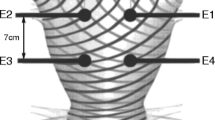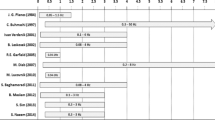Abstract
Preterm birth anticipation is a crucial task that can reduce both the rate and the complications of preterm birth. Electrohysterogram (EHG) or uterine electromyogram (EMG) data have shown that they can provide useful information for preterm birth anticipation. Four distinct time-domain features (mean absolute value, average amplitude change, difference in absolute standard deviation value, and log detector) that are commonly applied to EMG signal processing were utilized and investigated in this study. A single channel of EHG data was decomposed into its constituent components (i.e., into intrinsic mode functions) by using empirical mode decomposition (EMD) before their time-domain features were extracted. The time-domain features of the intrinsic mode functions of the EHG data associated with preterm and term births were applied for preterm-term birth classification by using a support vector machine with a radial basis function. The preterm-term birth classifications were validated by using 10-fold cross validation. From the computational results, it was shown that excellent preterm-term birth classification can be achieved by using single-channel EHG data. The computational results further suggested that the best overall performance concerning preterm-term birth classification was obtained when thirteen (out of sixteen) EMD-based time-domain features were applied. The best accuracy, sensitivity, specificity, and \(F_1\)-score achieved were 0.9382, 0.9130, 0.9634, and 0.9366, respectively.






Similar content being viewed by others
References
WHO (1976) WHO: recommended definitions, terminology and format for statistical tables related to the perinatal period and use of a new certificate for cause of perinatal deaths. Acta Obstet Gynecol Scand 56:247–253
Blencowe H, Cousens S, Chou D, Oestergaard M, Say L, Moller AB et al (2013) Born too soon: the global epidemiology of 15 million preterm births. Reprod Health 10(suppl 1):S2
Mayo Clinic. Premature birth; 2021 [cited May 27, 2021]. https://www.mayoclinic.org/diseases-conditions/premature-birth/symptoms-causes/syc-20376730
Wolrd Health Organization. Preterm birth; 2018 [cited May 27, 2021]. https://www.who.int/news-room/fact-sheets/detail/preterm-birth
Centers for Disease Control and Prevention. Preterm birth; 2020 [cited May 27, 2021]. https://www.cdc.gov/reproductivehealth/maternalinfanthealth/pretermbirth.htm
Fele-Žorž G, Kavšek G, Novak-Antolič v, Jager F (2008) A comparison of various linear and non-linear signal processing techniques to separate uterine EMG records of term and pre-term delivery groups. Med Biol Eng Comput 46:911–922
Maner WL, Garfield RE (2007) Identification of human term and preterm labor using artificial neural networks on uterine electromyography data. Ann Biomed Eng 35:465–473
Leman H, Marque C, Gondry J (1999) Use of the electrohysterogram signal for characterization of contractions during pregnancy. IEEE Trans Biomed Eng 46:1222–1229
Fergus P, Cheung P, Hussain A, Al-Jumeily D, Dobbins C, Iram S (2013) Prediction of preterm deliveries from EHG signals using machine learning. PLoS ONE 8:e77154
Peng J, Hao D, Yang L, Du M, Song X, Jiang H et al (2020) Evaluation of electrohysterogram measured from different gestational weeks for recognizing preterm delivery: a preliminary study using random forest. Biocybern Biomed Eng 40:352–362
Kaleem AM, Kokate RD (2021) Prediction of pre-term groups from EHG signals using optimal multi-kernel SVM. J Ambient Intell Humaniz Comput 12:3689–3703
Hussain AJ, Fergus P, Al-Askar H, Al-Jumeily D, Jager F (2015) Dynamic neural network architecture inspired by the immune algorithm to predict preterm deliveries in pregnant women. Neurocomputing 151:963–974
You J, Kim Y, Seok W, Lee S, Sim D, Park KS et al (2019) Multivariate time-frequency analysis of electrohysterogram for classification of term and preterm labor. J Electr Eng Technol 14:897–916
Hemthanon C, Janjarasjitt S (2019) Examination of time-domain features of EHG data for preterm-term birth classification. J Comput 30:41–54
Fergus P, Idowu I, Hussain A, Dobbins C (2016) Advanced artificial neural network classification for detecting preterm births using EHG records. Neurocomputing 188:42–49
Hemthanon C, Janjarasjitt S (2020) Correlation between time-domain features of electrohysterogram data of pregnant women and gestational age. In: Lin KP, Magjarevic R, de Carvalho P (eds) IFMBE Proceedings. vol 74, pp 212–218
Acharya UR, Sudarshan VK, Rong SQ, Tan Z, Lim CM, Koh JE et al (2017) Automated detection of premature delivery using empirical mode and wavelet packet decomposition techniques with uterine electromyogram signals. Comput Biol Med 85:33–42
Ren P, Yao S, Li J, Valdes-Sosa PA, Kendrick KM (2015) Improved prediction of preterm delivery using empirical mode decomposition analysis of uterine electromyography signals. PLoS ONE 10:e0132116
Chen L, Hao Y (2017) Feature extraction and classification of EHG between pregnancy and labour group using Hilbert-Huang transform and extreme learning machine. Comput Math Methods Med 10:10. https://doi.org/10.1155/2017/7949507
Smrdel A, Jager F (2015) Separating sets of term and pre-term uterine EMG records. Physiol Meas 36:341–355
Mas-Cabo J, Ye-Lin Y, Garcia-Casado J, Díaz-Martinez A, Perales-Marin A, Monfort-Ortiz R et al (2020) Robust characterization of the uterine myoelectrical activity in different obstetric scenarios. Entropy 22:743
Huang NE, Shen Z, Long SR, Wu MC, Shih HH, Zheng Q et al (1998) The empirical mode decomposition and the Hilbert spectrum for nonlinear and non-stationary time series analysis. Proc R Soc A. 454:903–995
Huang NE, Shen SS (2014) Hilbert-Huang transform and its applications, 2nd edn. World Scientific, New Jersey
Fontugne R, Borgnat P, Flandrin P (2017) Online empirical mode decomposition. In: 2017 IEEE international conference on acoustics, speech and signal processing (ICASSP), pp 4306–4310
Goldberger AL, Amaral LAN, Glass L, Hausdorff JM, Ivanov PC, Mark RG et al (2000) PhysioBank, PhysioToolkit, and PhysioNet: components of a new research resource for complex physiologic signals. Circulation 101(23):e215–e220
Huang NE, Wu MLC, Long SR, Shen SSP, Qu W, Gloersen P et al (2003) A confidence limit for the empirical mode decomposition and Hilbert spectral analysis. Proc R Soc A 459:2317–2345
Tibshirani Hastie R T, Friedman J (2009) The elements of statistical learning: data mining, inference, and prediction, 2nd edn. Springer, New York
Abe S (2010) Support vector machines for pattern classification, 2nd edn. Springer, London
Gu S, Tan Y, He X (2010) Discriminant analysis via support vectors. Neurocomputing 73:1669–1675
Funding
This study was funded by a TRF Research Career Development Grant jointly funded by the Thailand Research Fund (TRF) and Ubon Ratchathani University (Contract Number RSA6180041).
Author information
Authors and Affiliations
Corresponding author
Ethics declarations
Conflict of interest
The author declares that he has no conflict of interest.
Additional information
Publisher's Note
Springer Nature remains neutral with regard to jurisdictional claims in published maps and institutional affiliations.
Rights and permissions
About this article
Cite this article
Janjarasjitt, S. Preterm-term birth classification using EMD-based time-domain features of single-channel electrohysterogram data. Phys Eng Sci Med 44, 1151–1159 (2021). https://doi.org/10.1007/s13246-021-01051-w
Received:
Accepted:
Published:
Issue Date:
DOI: https://doi.org/10.1007/s13246-021-01051-w




